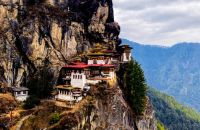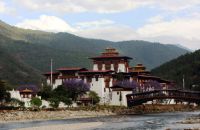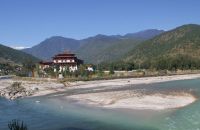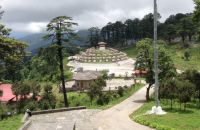Talk with our local travel specialist who can help organize your trip.
Travelling to Bhutan: Discover Guru Rinpoche’s Sacred Influence
Bhutan might be the most traditional Buddhist country in the Himalaya, but it’s not the Buddha himself who is the main object of Bhutanese affections. Instead, it’s Guru Rinpoche, a powerful 8th-century Tantric Buddhist Master with a neat line in magic and miracles. His image is everywhere in Bhutan and, if you hope to understand anything at all about Bhutan, then it’s essential to learn something about Guru Rinpoche, the patron saint of Bhutan.
The story begins far to the west of Bhutan in the Swat Valley of northwestern Pakistan. At opposite ends of the Himalaya from one and other, both Swat and Bhutan are noted for their steep-sided, forested mountain valleys but, today at least, that’s about as close as the similarities come. While Bhutan is known internationally for its policy of environmental protection and happiness above profit, the Swat Valley is known more for the Pakistani Taliban. But the Swat Valley wasn’t always a place of inward-looking and violent religious extremists.
Once, so very long ago there are only the most faded of reminders, the Swat Valley was the cradle of early Buddhism and over the centuries some of the key figures of Buddhism were brought up in this valley. One of those people was Guru Rinpoche (also known as Padmasambhava). His impact on the Himalaya, Tibetan Buddhism, and Bhutan in particular are hard to overestimate. In fact, it could be said that without Guru Rinpoche, there wouldn’t be a Bhutan at all.
Statues and images of Guru Rinpoche can be found in virtually every monastery, chapel, and shrine in Bhutan. In most cases, he sits in pride of place ahead of even the Current Buddha, Siddhartha Gautama. He has shaped the history, culture and legends of Bhutan. And so, it’s vital that anyone planning a visit to Bhutan has at least a basic grasp of who Bhutan’s favorite saint is.
Table of Content
Who was Guru Rinpoche
Very little is known about Guru Rinpoche’s early life. Even his place of birth is something of a mystery. It’s said that he was born in a place called Oddiyana, which most scholars believe was the Swat Valley, in the year 717. However, the guru wasn’t born in the way most of us mere mortals are. For a start, he emerged straight out of a lotus flower floating in a lake and he even skipped all that annoying toddler stage and came straight into the world as an eight-year-old child. But, perhaps the most remarkable thing about his birth is that he was born in a fully enlightened state, which is something even the Buddha himself couldn’t claim.
As an adult, he gained a reputation for his teachings and the miracles he pulled off. Because of this, he was soon summoned to Tibet by the king who requested his help in establishing Buddhism in the land. Guru Rinpoche is said to have helped establish the Samye monastery, one of the most important in the Tibetan Buddhist world and the very first Buddhist monastery in Tibet. In addition to this Guru Rinpoche’s teachings became
the cornerstone of the Nyingma tradition, the oldest of the four primary schools of Tibetan Buddhism. From Tibet, Guru Rinpoche moved rapidly around the Himalaya spreading Buddhism, but it was Bhutan that was the real focus of his attentions.
Tell us about his magic powers
If you’re intending to convert people to a new religious and spiritual idea, then it helps if you can impress them with miracles and magical powers. And this was certainly something Guru Rinpoche excelled at. He performed so many of these that they are commonly known as the Rinpoche Miracles. There are many reports of him flying through the heavens as a way of moving quickly around the Himalaya. In fact, it’s said that his arrival in Bhutan was on the back of a flying tiger. He is also said to have been able to control the elements by making storms subside and flowers to burst forth from snow-clad winter landscapes.
If he meditated anywhere for a long period, then the marks of his feet or hands were often burnt into the rock. Some of these can still be seen today in parts of Bhutan. But perhaps his two most important magical powers were he ability to subdue malevolent forces, demons and monsters that were getting in the way of the spread of Buddhism and his creation of hidden paradise valleys known as Beyuls where no harm could come to any living being.
What was he doing in Bhutan?
Legend tells us that Guru Rinpoche first arrived in Bhutan in the year 810 – nearly a century after his birth – and that he came in order to sort out a dispute between King Sindhu and his rival, King Naochhe. The dispute quickly got out of hand and turned into a full-scale war. At the time Buddhism didn’t exist in Bhutan and before heading into battle King Sindhu prayed to the deities of the area. When King Naochhe killed King Sindhu’s son, as well as 16 of his attendants, Sindhu blamed it on the deities and tried to destroy the abode of the main deity Shelging Kharpo. In response to this the deity turned the sky black and stole the king’s lifeforce.
Lying on his death bed and with local astrologers and healers unable to cure him the king summoned Guru Rinpoche to Bhutan to save him. After arriving in Bhutan, the first thing Guru Rinpoche did was to go into a deep meditation in a cave. After this, he quickly subdued the deity Shelging Kharpo (who from then on would be known as a demon) and persuaded the warring kings to make peace. So impressed were the kings with Rinpoche’s powers that they ordered their subjects to convert to Buddhism. Guru Rinpoche helped to oversee the construction of the first monasteries in Bhutan and was declared the patron saint of the country.
Featured Trips

Gomkora Tshechu Festival Tour - 13 days
Gomkora Tshechu Festival Tour observers the annual Gomkora festival in the Gomphu Kora situated at Trashigang in the eastern Bhutan. The 13 days tour is not just limited to eastern Bhutan it is also visiting the cultural icons of Bhutan
Inquire Now
Black Necked Crane Festival Tour - 8 days
Black Necked Crane Festival Tour in Bhutan lets you traverse into the Gangtey Nature Trail in central Bhutan while attending the Black Necked Crane Festival celebrated to welcome the rare creatures in the Phobjikha Valley.
Inquire NowWhere to travel next?
Get help from our travel specialists for holiday ideas that matches your interests.
Are there any sights in Bhutan I can visit related to Guru Rinpoche?
Guru Rinpoche’s three different visits to Bhutan might have taken place over a thousand years ago, but his legacy remains strong and there are a few sites related to him that can be visited on a Third Rock Adventures Bhutan tour.
Paro Taktsang (Tiger’s Nest Monastery)
By far the best-known site in Bhutan related to the great saint is the Paro Taktsang or Tiger’s Nest Monastery. The name comes because Guru Rinpoche is said to have flown to the cliff edge site where the monastery is now located on the back of a flying tiger. He then spent time meditating here as well as defeating local demons who were determined to stop the spread of Buddhism.
Kurjey Lhakhang
The place where the kings Sindhu and Naochhe battled it out is in the Bunthang Valley of central Bhutan. And the cave where Guru Rinpoche meditated before subduing the demon, saving the life of Sindhu and bringing peace to the valley, is now within the Kurjey Lhakhang, the most impressive of the valleys many monasteries. It’s perhaps the single most important monastery in Bhutan’s Buddhist history and continues to attract large numbers of pilgrims.
Singye Dzong
The remotest of the main sites related to Guru Rinpoche, the Singye Dzong, in the distant east of Bhutan, is believed to be the central point of one of the beyul’s created by the Guru. And, if any of the known (there are supposedly many that have not yet been found) beyuls are true to the vision of an untouched natural paradise then it’s this one. Getting there involves a hard three-day trek through a part of the country rarely seen by foreigners. Every year though numerous Bhutanese make the pilgrimage to pray here.
The above are only the three most important sites related to the guru but there are many other temples dedicated to him and imprints of his feet or hands burnt into rock. And of course, almost every monastery will contain a striking statue of him with his trademark narrow moustache.
Where to travel next?
Get help from our travel specialists for holiday ideas that matches your interests.
- Written by: Naba Raj Amgai
Updated: Oct, 15, 2024


























